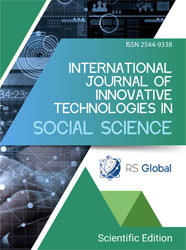INTEGRATING HEALTH, EDUCATION, AND SPORT: THE IMPACT OF SARS-COV-2 INFECTION AND COVID-19 VACCINATION ON BREASTFEEDING, NEONATAL IMMUNITY, AND EARLY PHYSICAL DEVELOPMENT
Abstract
The COVID-19 pandemic has underscored the critical role of public health education in promoting maternal and neonatal well-being. This systematic review examines the impact of SARS-CoV-2 infection and COVID-19 vaccination on breastfeeding practices, with a focus on viral transmission, the transfer of antibodies, and the broader implications for health education and early physical development. A comprehensive literature search covering studies from 2020 to 2024 was conducted. The review analyzed research on the presence of
SARS-CoV-2 in breast milk, antibody responses following natural infection and vaccination, and the subsequent effects on newborn health.
The results indicate that active transmission of SARS-CoV-2 via breast milk is extremely rare, with detected viral RNA not corresponding to infectious virus particles. Importantly, breast milk from both infected and vaccinated mothers contains significant levels of IgA and IgG antibodies, which confer passive immunity to newborns. Beyond immediate nutritional and immunological benefits, breastfeeding plays a pivotal role in fostering early physical development—a foundation that may influence later engagement in sports and active lifestyles. Moreover, the excellent safety profile of COVID-19 vaccines for breastfeeding women reinforces the integration of vaccination into public health education strategies aimed at promoting comprehensive maternal and child health.
These findings support the continued promotion of breastfeeding during the COVID-19 pandemic, not only for its direct health benefits but also for its broader educational and developmental impacts. The study advocates for interdisciplinary public health initiatives that integrate health education, vaccination campaigns, and the encouragement of early physical activity as essential elements in optimizing long-term health outcomes.
Objective: The aim of this study is to provide an in-depth analysis of the impact of SARS-CoV-2 infection and COVID-19 vaccination on breastfeeding, with a focus on the potential transmission of the virus and the transfer of antibodies through breast milk to newborns.
Materials and Methods: A systematic review of current scientific literature from 2020 to 2024 was conducted, focusing on studies examining the presence of SARS-CoV-2 in breast milk, levels of anti SARS-CoV-2 antibodies after infection and vaccination, and the clinical implications for newborn health. The search utilized a combination of keywords and logical operators such as "SARS-CoV-2, "“COVID-19, "“coronavirus, "“breastfeeding, "“lactation, "“human milk, " “transmission, "“antibodies, "“vaccination, " and”immunization." Electronic databases searched included PubMed, Scopus, Web of Science, and Embase. The review encompassed publications released from January 2020 to September 2024.
Conclusions: The analysis of available data indicates that the transmission of active virus through breast milk is extremely rare and does not pose a significant risk to the newborn. Detection of viral RNA in breast milk does not equate to the presence of replication-competent virus. Additionally, studies have shown that breast milk from both SARS-CoV-2-infected and COVID-19-vaccinated mothers contains specific antibodies, predominantly IgA and IgG. These antibodies may provide passive immunity to the newborn, potentially protecting against infection or mitigating disease severity. COVID-19 vaccination in breastfeeding women has been proven safe, with no significant adverse effects observed in mothers or their infants. The findings suggest that the benefits of breastfeeding outweigh the potential risks of SARS-CoV-2 transmission. Breastfeeding is recommended both during maternal infection and after COVID-19 vaccination. The available scientific evidence supports policies promoting breastfeeding as a safe and beneficial practice in the context of the COVID-19 pandemic.
References
World Health Organization. (2020). Coronavirus disease (COVID-19) pandemic. https://www.who.int/emergencies/diseases/novel-coronavirus-2019
World Health Organization. (2020, March 11). WHO Director-General's opening remarks at the media briefing on COVID-19 – 11 March 2020. https://www.who.int/director-general/speeches/detail/who-director-general-s-opening-remarks-at-the-media-briefing-on-covid-19---11-march-2020
Hosseinzadeh, P., Zareipour, M., Baljani, E., & Moradali, M. R. (2022). Social consequences of the COVID-19 pandemic: A systematic review. Investigación y Educación en Enfermería, 40(1), e10. https://doi.org/10.17533/udea.iee.v40n1e10
Nicola, M., Alsafi, Z., Sohrabi, C., et al. (2020). The socio-economic implications of the coronavirus pandemic (COVID-19): A review. International Journal of Surgery, 78, 185–193. https://doi.org/10.1016/j.ijsu.2020.04.018
Chavda, V. P., Vuppu, S., Mishra, T., et al. (2022). Recent review of COVID-19 management: Diagnosis, treatment and vaccination. Pharmacological Reports, 74(6), 1120–1148. https://doi.org/10.1007/s43440-022-00425-5
Centers for Disease Control and Prevention. (2023). People at increased risk. https://www.cdc.gov/coronavirus/2019-ncov/need-extra-precautions/index.htm
American Academy of Pediatrics. (2012). Breastfeeding and the use of human milk. Pediatrics, 129(3), e827–e841. https://pediatrics.aappublications.org/content/129/3/e827
Ballard, O., & Morrow, A. L. (2013). Human milk composition: Nutrients and bioactive factors. Pediatric Clinics of North America, 60(1), 49–74.
Pang, Z., Hu, R., Tian, L., Lou, F., Chen, Y., Wang, S., He, S., Zhu, S., An, X., Song, L., et al. (2022). A review of breastfeeding during the COVID-19 pandemic. Frontiers in Immunology, 13, 896068. https://doi.org/10.3389/fimmu.2022.896068
Chowdhury, R., Sinha, B., Sankar, M. J., Taneja, S., Bhandari, N., Rollins, N., Bahl, R., & Martines, J. (2015). Breastfeeding and maternal health outcomes: A systematic review and meta-analysis. Acta Paediatrica, 104(S467), 96–113. https://doi.org/10.1111/apa.13102
Chambers, C., Krogstad, P., Bertrand, K., et al. (2025). Evaluation for SARS-CoV-2 in breast milk from 18 infected women. JAMA.
Lackey, K. A., Pace, R. M., Williams, J. E., et al. (2020). SARS-CoV-2 and human milk: What is the evidence? Maternal & Child Nutrition, 16(4), e13032. https://doi.org/10.1111/mcn.13032
Jakuszko, K., Kościelska-Kasprzak, K., Żabińska, M., et al. (2021). Immune response to vaccination against COVID-19 in breastfeeding health workers. Vaccines (Basel), 9(6), 663. https://doi.org/10.3390/vaccines9060663
Gray, K. J., Bordt, E. A., Atyeo, C., et al. (2021). COVID-19 vaccine response in pregnant and lactating women: A cohort study. American Journal of Obstetrics and Gynecology, 225(3), 303.e1–303.e17. https://doi.org/10.1016/j.ajog.2021.03.023
Perl, S. H., Uzan-Yulzari, A., Klainer, H., et al. (2021). SARS-CoV-2–specific antibodies in breast milk after COVID-19 vaccination of breastfeeding women. JAMA, 325(19), 2013–2014. https://doi.org/10.1001/jama.2021.5782
Hochmayr, C., Winkler, I., Hammerl, M., Höller, A., Huber, E., Urbanek, M., Kiechl Kohlendorfer, U., Griesmaier, E., & Posod, A. (2024). Factors influencing antibody levels in human milk during the COVID-19 pandemic: An observational study. Nutrients, 16(14), 2320. https://doi.org/10.3390/nu16142320
Esteve-Palau, M., et al. (2025). Transfer of SARS-CoV-2 antibodies to neonates via breastfeeding post-vaccination. Pediatrics.
Amer, A. A., Amer, S. A., Badokhon, A., Hammad, S. M., Wasfy, M. A., Khan, M., Al-Harbi, T. A., Alobaid, S. Q., Eskander, G., Abdel-Azeem, A., Alshowair, A., & Ramadan, M. S. (2022). Investigation of adverse events associated with COVID-19 vaccination among pregnant women: A cross-sectional study. Journal of Maternal and Neonatal Health Research.
Wu, J., Zeng, W., Guo, Z., Jiang, X., & Li, H. (2020). Absence of SARS-CoV-2 RNA in breast milk from mothers with COVID-19: A multicenter study. Journal of Human Lactation, 36(3), 534–536. https://doi.org/10.1177/0890334420937678
Centeno-Tablante, E., Medina-Rivera, M., Finkelstein, J. L., et al. (2021). SARS-CoV-2 transmission through breastfeeding: A systematic review and meta-analysis. Pediatric Research, 89(5), 889–897. https://doi.org/10.1038/s41390-020-01171-0
Goad, J., Rudolph, J., & Rajkovic, A. (2020). Female reproductive tract has low concentration of SARS-CoV-2 receptors. Frontiers in Immunology, 11, 7735593. https://doi.org/10.3389/fimmu.2020.7735593
Boukoura, M. E., Dagla, M., Gourounti, K., Nieri, A. S., Taskou, C., Tsoukala, E., & Sarantaki, A. (2024). Breastfeeding practices for COVID-19-infected mothers: A systematic review and meta-analysis. Nursing Reports, 14(1), 516–531. https://doi.org/10.3390/nursrep14010040
Deng, H., Jin, Y., Sheng, M., Liu, M., Shen, J., Qian, W., Zou, G., Liao, Y., Liu, T., Ling, Y., & Xiaohonga, W. (2023). Safety and efficacy of COVID-19 vaccination during pregnancy among 1,024 pregnant women infected with the SARS-CoV-2 Omicron variant in Shanghai, China. Frontiers in Immunology, 14, 1303058. https://doi.org/10.3389/fimmu.2023.1303058
Fox, A., Marino, J., & Sano, K. (2021). Protective effects of breast milk antibodies against SARS-CoV-2 infection in neonates. Science Immunology, 6(60), eabn3129. https://doi.org/10.1126/sciimmunol.abn3129
Pace, R. M., Williams, J. E., Jarvinen, K. M., et al. (2021). Characterization of SARS-CoV-2-specific antibodies in human milk. Nature Communications, 12(1), 1236. https://doi.org/10.1038/s41467-021-21438-2
Proto, A., Agliardi, S., Pani, A., Renica, S., Gazzaniga, G., Giossi, R., Senatore, M., Di Ruscio, F., Campisi, D., Vismara, C., Panetta, V., Scaglione, F., & Martinelli, S. (2022). COVID-vaccines in pregnancy: Maternal and neonatal response over the first 9 months after delivery. Vaccine. https://doi.org/10.1016/j.vaccine.2022.09.021
Kelly, J. C., Carter, E. B., Raghuraman, N., et al. (2021). Anti-SARS-CoV-2 antibodies induced by COVID-19 mRNA vaccine in breast milk. Obstetrics & Gynecology, 137(5), 824–828. https://doi.org/10.1097/AOG.0000000000004333
Ahmed, A., Amer, S. A., Badokhon, A., Hammad, S. M., Wasfy, M. A., Khan, M., Al-Harbi, T. A., Alobaid, S. Q., Eskander, G., Abdel-Azeem, A., Alshowair, A., & Ramadan, M. S. (2024). Exploring COVID-19 vaccine adverse events among pregnant women: A cross-sectional study. Therapeutic Advances in Vaccines and Immunotherapy, 12, 25151355241285594. https://doi.org/10.1177/25151355241285594
Narayanaswamy, V., et al. (2021). Antibody responses in lactating women following COVID-19 vaccination: A comparative analysis of vaccine platforms. Clinical Infectious Diseases, 73(11), e4287–e4295. https://doi.org/10.1093/cid/ciab762
Shah, M. D., Miller, N., & Saugstad, O. D. (2024). Newborns at risk of COVID-19, the story continues. Journal of Perinatal Medicine. https://doi.org/10.1515/jpm-2024-0125
Views:
7
Downloads:
1
Copyright (c) 2025 Patrycja Kinga Marta, Natalia Morawiecka, Agata Ossolińska, Magdalena Rosa-Bończak, Gabriela Monika Ferfecka, Klaudia Anna Pawełek, Filip Maciej Huzarski, Mikołaj Asztabski, Patrycja Misiaszek, Szymon Rydzewski

This work is licensed under a Creative Commons Attribution 4.0 International License.
All articles are published in open-access and licensed under a Creative Commons Attribution 4.0 International License (CC BY 4.0). Hence, authors retain copyright to the content of the articles.
CC BY 4.0 License allows content to be copied, adapted, displayed, distributed, re-published or otherwise re-used for any purpose including for adaptation and commercial use provided the content is attributed.















